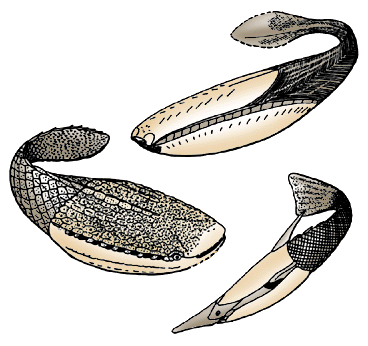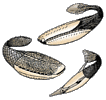Pteraspidomorphi
Philippe Janvier



This tree diagram shows the relationships between several groups of organisms.
The root of the current tree connects the organisms featured in this tree to their containing group and the rest of the Tree of Life. The basal branching point in the tree represents the ancestor of the other groups in the tree. This ancestor diversified over time into several descendent subgroups, which are represented as internal nodes and terminal taxa to the right.

You can click on the root to travel down the Tree of Life all the way to the root of all Life, and you can click on the names of descendent subgroups to travel up the Tree of Life all the way to individual species.
For more information on ToL tree formatting, please see Interpreting the Tree or Classification. To learn more about phylogenetic trees, please visit our Phylogenetic Biology pages.
close boxThe main characteristics supporting the nodes of this phylogeny are:
- Node 1: Gill openings along the dorsolateral margin of the head armor.
- Node 2: Dentine with large tubules in tubercles.
Introduction
The Pteraspidomorphi, or pteraspidomorphs, is a group of fossil jawless vertebrates which lived from the Early Ordovician to the Late Devonian (i.e. from 470 to 370 million years ago). They possess and extensive dermal armor covering the head, and a scaly tail. They have no other fin than the caudal fin. Their head armor, which always comprises large, median dorsal and ventral plates (or shields), is generally oblong, and this gives them the aspect of a tadpole. Pteraspidormorphs have long been regarded as closely related -or even ancestral- to jawed vertebrates, but the few characteristics they share with the latter are now considered as primitive for all vertebrates.
Most pteraspidomorphs were marine, but lived very near to the shore, in lagoons and deltas. Some groups are thought to have been fresh water. They were certainly bottom-dewellers, as shown by traces of abrasion of the ventral surface of their headshield.
Characteristics
Pteraspidomorphs are characterized by:
- Large, median ventral and dorsal dermal plates, or "discs", which form most of the head armor.
- Oak leaf-shaped tubercles on the dermal plates (lost independently several times)
The Pteraspidomorphi include four clades, the Arandaspida, Astraspida, Eriptychiida and Heterostraci. Their dermal plates and scales are made up of acellular bone, or aspidine, but this is thought to be a primitive condition for the dermal bone of all bony vertebrates. Pteraspidomorphs have no calcified endoskeleton, except for eriptychiids and possibly arandaspids, which show traces of calcified cartilage. Pteraspidomorphs generally have a fusiform shape, with a head armor almost as long as the body, and have no other fin than the caudal fin, which is generally pad- or fan-shaped. The mouth is armed with elongate dermal plates which could expand as the mouth opened, and served as a scoop. The internal surface of the dermal plates -at any rate in heterostracans- shows impressions of the gills, brain, two vertical semicircular canal and distinctly paired nasal capsules. The nasal capsules of heterostracans seem to have opened ventrally into a separate median duct comparable to the nasopharyngeal duct of hagfishes. They are put among the Vertebrata because some heterostracans show impressions of arcualia (dorsal components of the vertebrae), and because they have a well-developed sensory-line system.
Discussion of Phylogenetic Relationships
Pteraspidomorphs have been first regarded as related to bony fishes, then to sharks, then ancestral to hagfishes, and finally as the closest jawless relatives of the gnathostomes. This last theory was based on the fact that they seem to have a paired olfactory organ and a sensory-line pattern which is quite similar to that of the gnathostomes. These characteristics are, however, likely to be general for either the vertebrates or, at any rate, for the ensemble of all "ostracoderms"+ the gnathostomes. Other "ostracoderms", such as the Galeaspida are now known to have a paired olfactory organ. Current phylogenetic analysis using a large number of characteristics (see Vertebrata page) now place pteraspidomorphs as the sister-group of all other "ostracoderms" and the gnathostomes.
The interrelationships of the Pteraspidomorphi are still poorly corroborated. The Astraspida share with the Heterostraci the dorsolateral position of the gill openings (single in heterostracans). The poorly known Eriptychiida seem to share with the Heterostraci the same type of dentine in the tubercles.
References
Blieck, A., Elliott, D. and Gagnier, P. Y. (1991). Some questions concerning the phylogenetic relationships of heterostracans, Ordovician to Devonian jawless vertebrates. In M.-M. Chang et al. (Eds.), Early vertebrates and related problems of evolutionary biology. Science Press, Beijing.
Halstead, L. B. (1982). Evolutionary trends and the phylogeny of the Agnatha. In Problems of phylogenetic reconstruction, The Systematics Association Special Volume, No. 21, (ed. K. A. Joysey and A. E. Friday), pp. 159-196. Academic Press, London.
Janvier, P. (1996a). Early vertebrates. Oxford Monographs in Geology and Geophysics, 33, Oxford University Press, Oxford.
Janvier, P. (1996b). The dawn of the vertebrates: characters versus common ascent in current vertebrate phylogenies. Palaeontology, 39, 259-287.
Stensiö, E.A. (1964). Les Cyclostomes fossiles ou Ostracodermes. In: Traité de paléontologie (ed. J. Piveteau), Vol. 4(1), pp. 96-383, Masson, Paris
Title Illustrations

| Scientific Name | Pteraspida |
|---|---|
| Comments | Pteraspidomorphs are among the earliest known vertebrates. They were jawless and possessed a massive dermal skeleton. They are characterized by their dermal head armor having large, median, ventral and dorsal plates or "shields" (red). |
| Reference | after Janvier 1996 |
| Specimen Condition | Fossil |
| Image Use |
 This media file is licensed under the Creative Commons Attribution License - Version 3.0. This media file is licensed under the Creative Commons Attribution License - Version 3.0.
|
| Copyright |
© 1997

|
About This Page

Muséum National d'Histoire Naturelle Paris, France
Page copyright © 1997
 Page: Tree of Life
Pteraspidomorphi.
Authored by
Philippe Janvier.
The TEXT of this page is licensed under the
Creative Commons Attribution License - Version 3.0. Note that images and other media
featured on this page are each governed by their own license, and they may or may not be available
for reuse. Click on an image or a media link to access the media data window, which provides the
relevant licensing information. For the general terms and conditions of ToL material reuse and
redistribution, please see the Tree of Life Copyright
Policies.
Page: Tree of Life
Pteraspidomorphi.
Authored by
Philippe Janvier.
The TEXT of this page is licensed under the
Creative Commons Attribution License - Version 3.0. Note that images and other media
featured on this page are each governed by their own license, and they may or may not be available
for reuse. Click on an image or a media link to access the media data window, which provides the
relevant licensing information. For the general terms and conditions of ToL material reuse and
redistribution, please see the Tree of Life Copyright
Policies.
Citing this page:
Janvier, Philippe. 1997. Pteraspidomorphi. Version 01 January 1997 (under construction). http://tolweb.org/Pteraspidomorphi/14834/1997.01.01 in The Tree of Life Web Project, http://tolweb.org/







 Go to quick links
Go to quick search
Go to navigation for this section of the ToL site
Go to detailed links for the ToL site
Go to quick links
Go to quick search
Go to navigation for this section of the ToL site
Go to detailed links for the ToL site